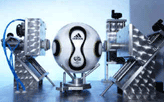
« PREVIOUS ENTRY
Study: In the long run, we regret virtue more than vice

Behold the “Teamgeist” — a soccer ball with such crazy-new physics that it is apparently annoying the heck out of World Cup goalkeepers. Adidas recently invented the Teamgeist at the behest of FIFA, which wanted a ball that would give superior control when kicked. Whereas a normal soccer ball is composed of 32 panels stitched together, the Teamgeist is made of only 14. This makes it rounder and less likely to pick up water on a rainy day, and improves the kicking surface.
Whatever one thinks of Adidas’ PR on this one, the players themselves are noticing a difference, as a story in Deutsche Welle points out:
“With long shots, it floats and moves a lot which makes it difficult to read,” said Brazilian superstar Ronaldinho. “It’s perfect for attackers.” [snip]
“Something is obviously going on with the ball,” says USA’s Kasey Keller, who was the victim of the curling terror unleashed by the Czech Republic’s Rosicky on June 12. “It’s a very light ball. The difference is only a fraction of a second but it’s a big difference. This ball has a wobble. It’s not an easy ball to catch.”
“At the last World Cup there were hardly any spectacular long-range goals,” Keller added. “We had two in the first game so something is obviously going on.”
I’m afraid I haven’t been watching the World Cup (not because, like most Americans, I think soccer/football is boring, but because I don’t watch any sports). Anyone have any thoughts on whether this ball has actually had the effect pundits claim it has?
I'm Clive Thompson, the author of Smarter Than You Think: How Technology is Changing Our Minds for the Better (Penguin Press). You can order the book now at Amazon, Barnes and Noble, Powells, Indiebound, or through your local bookstore! I'm also a contributing writer for the New York Times Magazine and a columnist for Wired magazine. Email is here or ping me via the antiquated form of AOL IM (pomeranian99).

ECHO
Erik Weissengruber
Vespaboy
Terri Senft
Tom Igoe
El Rey Del Art
Morgan Noel
Maura Johnston
Cori Eckert
Heather Gold
Andrew Hearst
Chris Allbritton
Bret Dawson
Michele Tepper
Sharyn November
Gail Jaitin
Barnaby Marshall
Frankly, I'd Rather Not
The Shifted Librarian
Ryan Bigge
Nick Denton
Howard Sherman's Nuggets
Serial Deviant
Ellen McDermott
Jeff Liu
Marc Kelsey
Chris Shieh
Iron Monkey
Diversions
Rob Toole
Donut Rock City
Ross Judson
Idle Words
J-Walk Blog
The Antic Muse
Tribblescape
Little Things
Jeff Heer
Abstract Dynamics
Snark Market
Plastic Bag
Sensory Impact
Incoming Signals
MemeFirst
MemoryCard
Majikthise
Ludonauts
Boing Boing
Slashdot
Atrios
Smart Mobs
Plastic
Ludology.org
The Feature
Gizmodo
game girl
Mindjack
Techdirt Wireless News
Corante Gaming blog
Corante Social Software blog
ECHO
SciTech Daily
Arts and Letters Daily
Textually.org
BlogPulse
Robots.net
Alan Reiter's Wireless Data Weblog
Brad DeLong
Viral Marketing Blog
Gameblogs
Slashdot Games